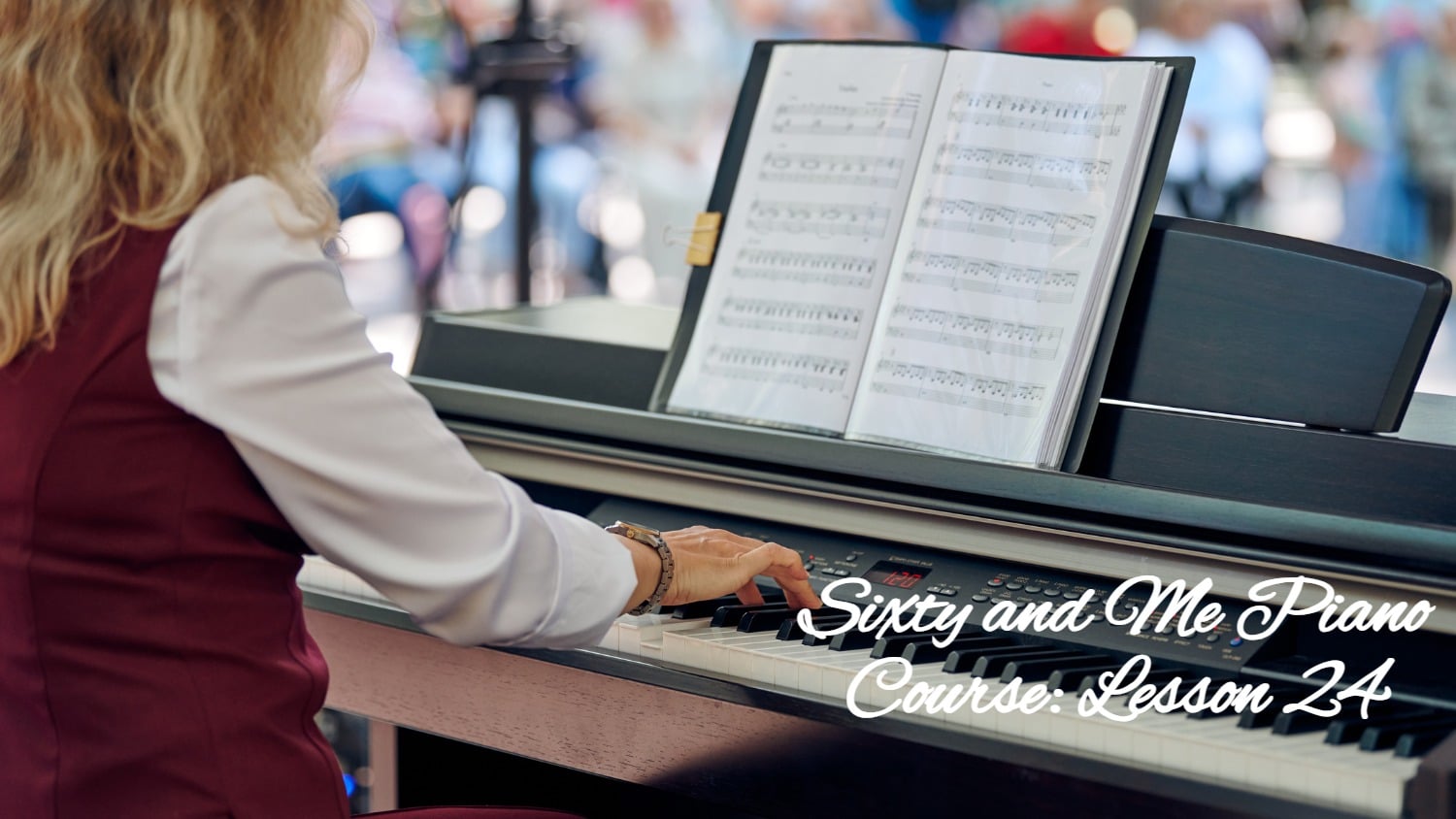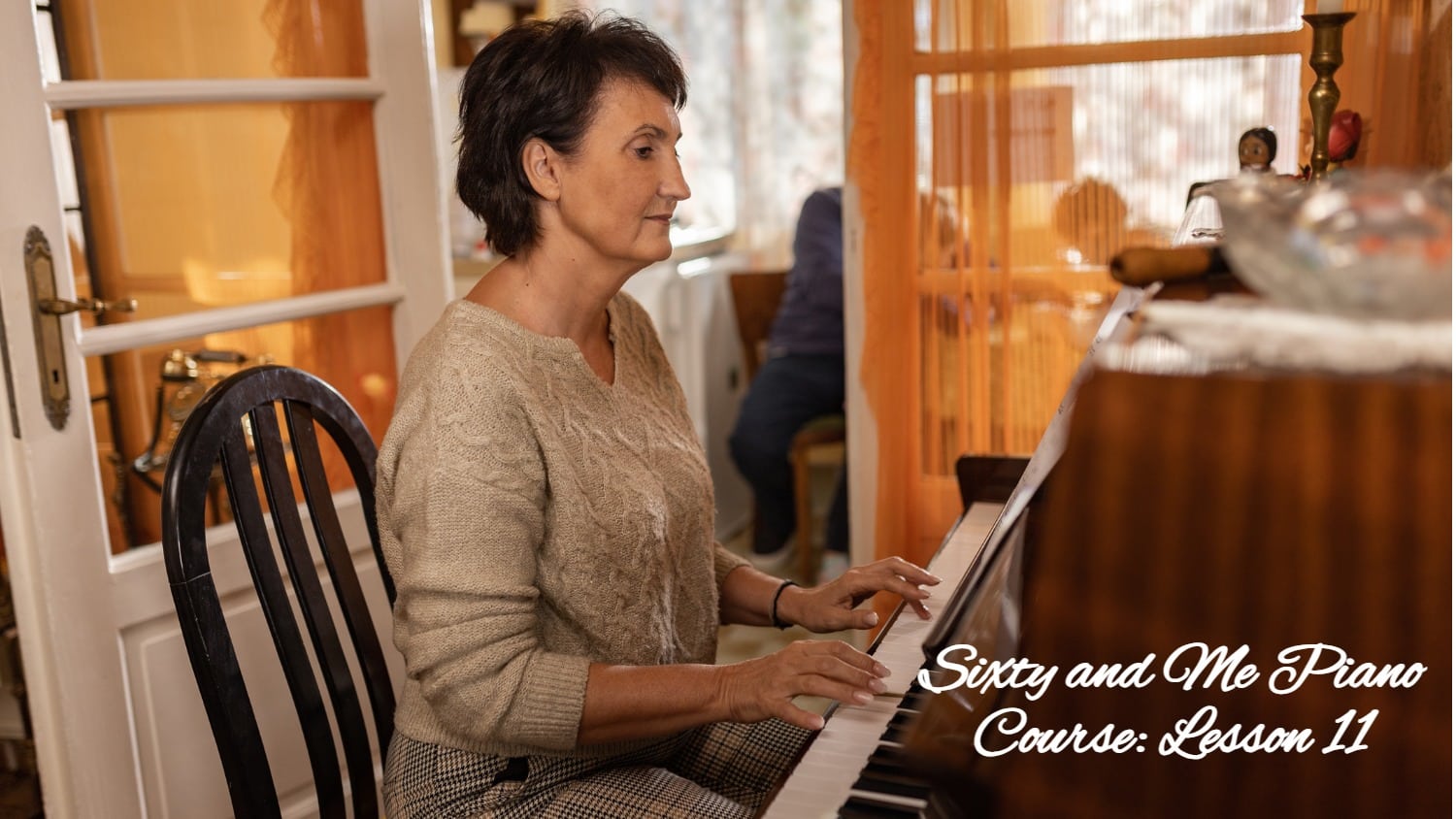
Piano Lesson 5: Reading Bass G, New Exercise #2, and a St. Patrick’s Day Bonus
If you are taking your lessons on my timeline then it is almost St. Patrick’s Day! I love Irish music and thought it might be fun for you to play some Irish music too! The focus for Lesson 5 is reading Bass G. I showed you how to play Left Hand ‘G’s in Lesson 4 and in today’s lessons you will be reading that G note in the Bass Staff! You will play Bass G in The Irish Washerwoman, a fun and popular traditional Irish jig (a dance) which I arranged just for Sixty and Me subscribers.
I am giving you many pieces plus a new exercise in Lesson 5! If you don’t have time to learn everything in the next two weeks, no problem. Take your time and wait to play Lesson 6 until you have completed the pieces in Lesson 5. When I say “completed” I mean that you know them well enough to play them to a steady beat. Your beat is ideally slow and steady.
[NOTE: If you are just joining us for the first time, the list of my previous Sixty and Me Free Piano Lessons is at the bottom of this page.]
5.1 Gorilla G and an Introduction to p.21-26
In Upper Hands Piano, BOOK 1, p.11, we discussed the BASS CLEF. It is also known as the F-CLEF because its two dots indicate the F on the 4th line from the bottom of the staff. Today you will be reading the G that is one note above that F.
This note G is in the top space of the BASS, and you will play it with your left hand 1-finger. Open your book to p.22 to see “Gorilla G.” This Gorilla eating Green Grass will help you to remember that G is in the top space of the BASS STAFF. It is the G below middle C.
5.2 Lightly Row, p.23
Before you start playing any song or piece, you want to get both of your hands in position for the first notes they will play. For Lightly Row, put your right-hand fingers 1-2-3-4-5 on middle C-D-E-F-G, and put your left hand 1-finger on the G below middle C. If you wait to position your left hand on the G until the third line, you will likely disrupt your tempo. It’s best to have both hands ready in position before you begin playing.
5.3 The Three Sailor Boys p.24 Review: Playing Tied Notes
On p.19 we talked a little bit about the “tie.” A tie is a curved line connecting two notes that are the same. When you see a tie, play the first note, then hold it for the value of both notes. For The Three Sailor Boys on p.24, you will see many ties.
Notice that there are three ties in the bass staff on the first line. That means play the first bass G, then hold it down for the next three measures. You will do the same for the following lines. There is also a tie in the right hand at the end of the song. You will play the first C for the word “sea” for four beats, then hold it for another four beats in the final measure.
Keyboard Worksheet, p. 25
Write the letter D on each keyboard, then write the other letters in the order I gave you. Hopefully you are about ready to start playing these pages without your letter strip. But if not, keep quizzing yourself on the key names until you know them well. You can use the keyboard charts on p. 6 or 8 to make sure you are guessing the keys correctly.
Musical Mind Games, p.25
Fill in the letters below the notes to read each phrase. The first note is D.
5.4 Gavotte p.26
A Gavotte is a French folk dance. Much of our classical music was composed for people to dance to. Notice that there is a repeat sign at the end of the piece. When you see a double bar line with two dots inside of the lines, that is a repeat sign. Go back to the beginning without stopping and play it again.
5.5 Barcarole p.26, Clapping Rhythms, and the ¾ Time Signature!
Be sure to watch my video for the Barcarole where I demonstrate clapping and playing the ¾ time signature. A Barcarole is a traditional song meant to be sung by Venetian gondoliers to the gentle rhythm of their rowing, so play it slowly and smoothly. Practicing the Barcarole will also help you to play The Irish Washerwoman with the correct rhythm. Count each measure 1-2-3, 1-2-3 without pausing between the measures.
5.6 The Irish Washerwoman!
This jig is so much fun to play, with the melody moving between the hands. I am demonstrating it at three tempos: slow, medium, and super-fast so that you have something to aspire to! You can play it over and over getting a bit faster each time.
To print the sheet music, scroll to the bottom of the Sixty and Me files here.
Please Note: watch for the circled fingering. That alerts you to the fact that you won’t be playing a key that falls under your fingers naturally. You will have to move your hand or stretch a finger in order to play the correct note.
EXERCISE #2
If you have played Exercise #1 through all 12 keys at least twice, you are ready to move on to Exercise #2! This is a great exercise for addressing the difficulty of playing neighboring fingers. It is especially awkward playing your 4- and 5-fingers one after another. This exercise will help!
I wrote this exercise in C. Practice it in C for a while, then move on to G, D, etc. in the same order you played Exercise #1, in all 12 keys. Always play the 5 notes of the pentascale first, before playing the exercise.
You can use Exercise #1 or the Pentascales chart at the back of the book to remind you of the notes for each key. I have demonstrated Exercise #2 in C and G, and also B, because B position is so difficult to play. As with Exercise #1, you must move your hand forward in order to reach all the black keys in B position.
5.7 Exercise #2 in C
5.8 Exercise #2 in G
5.9 Exercise #2 in B
Whew! I have given you a lot of new things to play for just two quick weeks. Move at your own pace, and work through everything in Lesson 5 before starting Lesson 6.
Passion Practice!
- Start playing Exercise #2 in C this week, then in C and G next week.
- Fill in the worksheets and play the pieces on pages 21-26. Be sure to watch my videos to check your rhythm. Practice slowly and work up to playing each song evenly to a steady beat.
- Play The Irish Washerwoman, after you watch video 5.5 (Barcarole) about clapping and playing the ¾ time signature. Don’t forget to wear green on St. Patrick’s Day!
- Remember the GREEN GRASS-eating GORILLA-G is in the top space in the bass. And practice finding your keys without your letter strip if you are still using it to play songs.
Previous Sixty and Me Piano Lessons:
Introduction to the Piano Course
Lesson 1: Let Our Classes Begin
Lesson 2: Reading and Playing Our First 5 Notes
Lesson 3: 3 Health Issues That Might Affect Your Piano Playing
Lesson 4: Feel the Beat and Get Creative!
Let’s Have a Conversation
Do you have a St. Patrick’s Day tradition? Have you heard the Irish Washerwoman song before in films or at music festivals? How does it feel playing with your hands together? I would love for you to share your piano lesson experiences and questions!
Tags Piano Lessons







Thank you for these lessons, Gaili. I am so happy with myself because I am making progress under your excellent guidance. The pace of these lessons is perfect for me and I am grateful for that. Also, you look great in your green and thanks for the St. Patrick’s Day song!
Thanks Patricia – I’m so glad the pace is working for you. The next lesson will be shorter to compensate for today’s many pieces. I hope you enjoy playing The Irish Washerwoman! ☘️